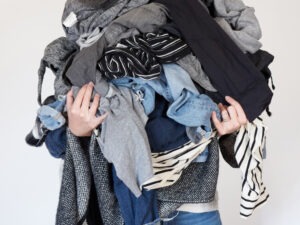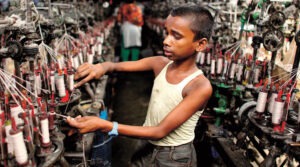When it comes to updating our wardrobes, there are options to consider when deciding what to buy and where to spend our money that relate to the true cost of our clothing consumption.

Some of us prefer to save our dollars and support the low cost clothing suppliers, some of us choose to go second hand and save clothes going to waste, some of us slow our wardrobe down and wear a quality, natural fibre garment until we can’t repair the decade old holes anymore.
As consumers we have power and with it responsibility to consciously consume and purchase items that contribute to fair work practices that also hold environmental standards.
However when considering the cost of living + the average income + the comparison between low cost clothing and sustainable clothing, having choices over our wardrobe budget can be a luxury and not an automatic right.
Do We Over Consume Clothing?

On top of where to spend our money and who to support in our purchases, it’s important to address the frequency of our consumption. On average, a garment will be worn seven times before it’s discarded. This is a BIG issue with overconsumption thats affecting the amount of fabric going to landfill and supporting the fast fashion industry that exploits it’s workers who manufacture and produce low cost garments.
Fast Fashion Facts
 An Oxfam Australia report states that fast fashion factory workers who make low cost and fast fashion garments could be paid less than 39 cents an hour, these workers would have a low quality of life based on needing to work extreme hours for below minimum pay. These workers are humans who need to pay rent, and feed their families which is impossible in these circumstances.
An Oxfam Australia report states that fast fashion factory workers who make low cost and fast fashion garments could be paid less than 39 cents an hour, these workers would have a low quality of life based on needing to work extreme hours for below minimum pay. These workers are humans who need to pay rent, and feed their families which is impossible in these circumstances.
The bottom line is that fast fashion IS contributing to human exploitation, child labour and poverty.
The True Cost Of Clothing
Let’s have a look at the true cost of our clothing consumption choices.
Low cost clothing suppliers are almost certainly associated with Fast Fashion, Poor Workers Conditions and Synthetic + Toxic Materials.
Where as sustainable, natural fibre garments are often created with ethical and fair work practices at the beginning of the production line.
A T-shirt that costs $7 in no way represents the true cost of that garment.
$7 could not cover the cost of the fabric +
Workers compensation to the hands that made it +
Shipping and handling costs (90% of the time coming from overseas) +
Wages and Overheads that go with selling the T-shirt in a store
Compare this to a sustainable, natural fibre T-shirt that costs $60, this price would likely represent the true cost of the garment.

$60 could cover the cost of fabric +
Workers compensation to the hands that made it +
Shipping and handling costs (varying between Australian and Overseas) +
Wages and overheads that go with selling the T-shirt in a store.
Environmental & Health Benefits
The BONUS of having a natural Hemp Fibre garment in your wardrobe rotation is that the fibres are breathable, antimicrobial and durable.
This means that your body can healthily function, breathe and sweat in this T-shirt without absorbing toxic chemicals.
A natural Hemp fibre T-shirt can be washed without fear of what microplastics are being released down the drain.
You can trust that the dyes used to colour your Hemp fibre T-shirt are going to be natural most of the time.
All of this added HEALTH bonus to your T-shirt is what makes this true cost of $60 beyond worth it.
Invest in yourself, in the planet and in the future of sustainable lifestyles by investing in Australian Industry Hemp Clothing, next time you need to update your wardrobe.
Shop our sustainable hemp clothing range HERE
Use code ‘SUSTAINABLE10’ for 10% off your purchase!
*excludes Hemp Clothing Australia range, Code expires 25th October
Leave a Reply